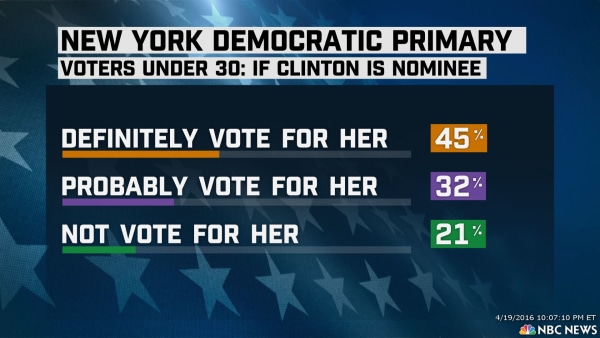As a candidate running on the Democratic Party ticket, Hillary Clinton is tapping in to these traditional bases of support to strengthen her run for the presidency as well as show that she has the ability to attract voters from all across the country and from a variety of backgrounds. One statement that she has continuously made regarding this idea in recent weeks is that "I've gotten more votes than anybody running on either side" from a "wide, broad base" as she recently announced on CBS's Face the Nation with John Dickerson. By stating these claims, Clinton hopes to continue to add to her supporters as voters realize that she will likely be the Democratic Nominee and potentially the next President of the United States.
According to exit polls from CNN Politics and the most recent New York Primary held on April 19th, this "wide, broad base" of supporters comes from women, voters over the age of 30, and voters who identify with the Democratic Party. While the New York Primary is a closed primary, meaning that only people who have registered with a political party prior to the election can vote, there is still a substantial amount of data that can be gathered from these polls. For instance, Clinton won the women's vote 67% compared to Sanders 37%; the African American vote 75% to 25%; and the Latino vote 64% to 36%. However, when it came to education and income levels, voters were almost evenly split between the two candidates with Clinton beating Sanders in these areas by an average of 10 points rather than something more drastic like 20 or 30 points.
The large margin that Clinton has been able to secure among minority voters echoes the large bases of support that President Obama achieved when he ran for president in both 2008 and 2012. Obama's coalition was made up of younger voters who may have never voted before and minority voters who tended to be overshadowed by other candidates in the race. Clinton has latched on to this idea by promoting her campaign as a continuation of Obama's presidency in some ways, in order to gain support from his supporters.
However, Clinton has had trouble gaining support from specific groups during this election cycle, most notably younger voters under the age of 30. These voters are the voters that helped push Obama to his wins in 2008 and 2012 because they had never voted before and were excited to become a part of the political process and use new technologies such as Twitter to get their opinions heard. These voters tend to overwhelmingly support Sanders as can be seen in many exit polls where Sanders has beaten Clinton by over 30 points when it comes to voters under 30. Clinton has also struggled to gain support from white, rural men and may also be struggling to get votes from unions. Unions are traditionally a large part of the Democratic base, and still are, they just tend to favor Sanders over Clinton in certain cases. One of Sanders' key issues has been income inequality which many unions face as they negotiate contracts for their workers in order to raise wages so that their workers can support themselves. While Sanders has said that he strongly supports the $15 minimum wage movement, Clinton has said that she supports a movement to raise the minimum wage to $12, a number not quite as extreme as $15. Though these positions seem similar to the outside eye, Clinton may need to strengthen her support of an increase in minimum wage as it gets closer to the general election so she can gain support from Sanders' supporters if he does not get the nomination in July.
Clinton will need to continue to work on gaining support from Sanders' voters in the coming months in order to ensure that they vote for her rather than voting for the Republican Nominee or not voting at all. The following image is from NBC News as part of their coverage after the New York Primary which shows what voters under 30, some of Sanders strongest supporters, would do if Clinton was the Democratic Nominee. While it is a great sign that 45% would definitely vote for her, Clinton must work to gain support from those who say they would probably vote for her and those who would not vote for her. Gaining support from these voters means that there is a smaller chance for Trump to convert these voters to his campaign and lose the race for the Democrats. To do this Clinton must continue to tout her leadership experience and showcase how her qualities would make her the best fit to be the next president. She will also need to make sure to avoid any gaffes and work on the character that her campaign gives off so that voters can see she is more honest and trustworthy than the media tends to portray her as.

No comments:
Post a Comment